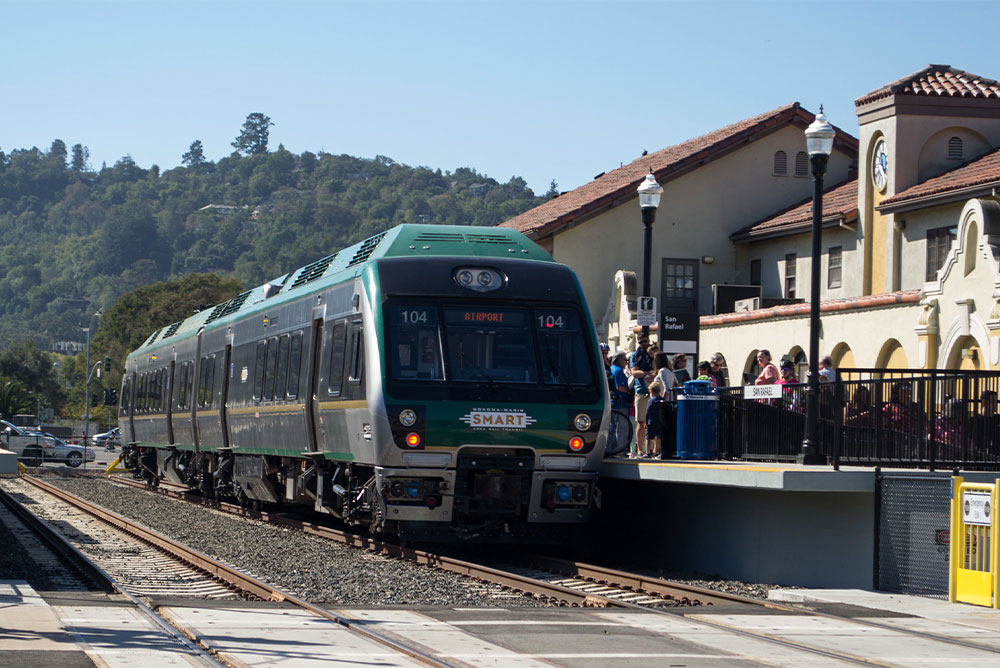
Pictured above at the San Rafael depot, the Sonoma-Marin Area Rail Transit (SMART) train and its plans for expansion serve as examples of how infrastructure can further connect Californians, argues columnist Joe Mathews. Courtesy of Don Barrett/Flickr (CC BY-NC-ND 2.0).
If this train is so SMART, why can’t I find it?
That’s the question I asked myself in Larkspur, in Marin County, after arriving on the ferry from San Francisco one morning earlier this summer.
I was on my way up to Petaluma to do some reporting, and had been looking forward to experiencing what promises to be California’s newest and most spectacular ferry-to-train connection: the Golden Gate Ferry to the SMART train, the light rail line running for 49 miles through Marin and Sonoma counties.
SMART may be little known statewide, but it offers big inspiration, as an example of Californians finding ways to build infrastructure that connects us, even in this era of division and polarization. It’s also a window on where California, even with its population falling, is still growing—on the increasingly urban edges of our larger metropolitan areas, in places like Fairfield, Riverside, and Escondido.
SMART opened in 2017, offering 43 miles of service from Marin’s San Rafael up to Santa Rosa’s Charles M. Schulz airport. It was built for peanuts—just $400 million. (For comparison, the estimate for a 12-mile light-rail extension from Glendora to Montclair in Southern California is $2.1 billion). An extension south from San Rafael to Larkspur and its ferry opened just before the pandemic hit, crushing demand for trains and ferries.
But ridership has been rebounding. And SMART is still doggedly working to expand. It’s adding a second Petaluma station, on the north side of town; further developing its successful #BikeTrainSynergy (20 percent of riders bring bicycles on board); and creating a micro-transit service to carry passengers the mile from its airport station to the actual airport.
It’s also working on becoming bigger, in ways that might better accommodate a post-pandemic future.
SMART has begun construction on an extension up the 101 freeway corridor to Windsor, though it’s paused that work while awaiting a state Supreme Court decision on the validity of the bridge toll increase funding the project. Eventually, SMART plans to take the train farther—to Cloverdale, on Mendocino County’s doorstep, 80 miles north of the Golden Gate Bridge.
SMART also has studied a new line east from its Novato-Hamilton station across the North Bay to reach the Interstate 80 corridor at Suisun City, which is slightly closer to Sacramento than San Francisco. There, SMART would share a station with Amtrak’s Capitol Corridor service, which connects the state capital and San Jose.
A feasibility study suggests such a line could be constructed quickly—in six years or less—and perhaps for just $1 billion. That’s good news, because climate change makes establishing new North Bay links important. The state has said that California State Route 37, the area’s main east-west thoroughfare, could be “permanently submerged” by 2040 because of storms and rising sea levels. The highway is already seeing closures because of flooding.
With all these projects, SMART is seeking to serve both visitors to California, and Californians who may be less likely to live in the middle of our biggest cities, but still want to be connected to them. Indeed, transit projects like SMART and the ACE train, which runs through the Altamont corridor and is being extended south and east through Modesto to Merced, are helping to knit Northern California into what some wonks call “The Mega-Region.” That conception imagines the “Bay Area” reaching as far as Lake Tahoe or Fresno.
Of course, serving such a large area requires making smart links accessible to real people. I couldn’t find such a thing at the Larkspur ferry.
The experience was mortifying because I had been bragging about SMART to my companion that day, a Swiss-Swedish journalist-colleague. After decades of traveling the world by rail, he is a train snob, and he began making little jokes as soon as I turned left off the ferry, wandered to the edge of its parking lot—and couldn’t find the train. Unable to locate the platform using the navigation app on my balky smartphone, I started moving toward a tunnel used by bicyclists and pedestrians. Still no train.
Eventually we wandered to the right side of the parking lot, crossed busy Sir Francis Drake Boulevard, and meandered around a curve in a smaller street, through two office parking lots, and up a narrow driveway to reach the train station. On board, the ride was fine, though my European friend pressed a conductor on why the train runs on diesel, not electricity (the answer to the wisenheimer: to save money in an America that doesn’t invest much in trains).
The good news is that, if my colleague ever comes back to the North Bay, the problem should be solved. After making some calls, I learned that SMART has repeatedly put up sandwich boards and posted signs to show the path from ferry to train and back—but these keep getting stolen or blown away by winds. As I write this, they’re enacting a more permanent solution: Vinyl decals will be applied to the pavement to mark the safest route.
These decals are called breadcrumbs, and you can follow them, slowly and carefully, to California’s future.




Send A Letter To the Editors